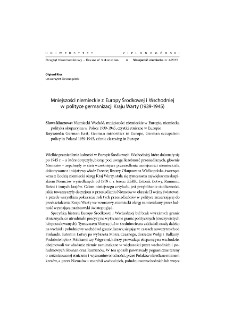Digital Library of Zielona Góra contains 9 283 digital objects
Object
Title: The German minorities in Central and Eastern Europe and the Germanization policy in Warthegau 1939-1945 = Mniejszości niemieckie z Europy Środkowej i Wschodniej w polityce germanizacji kraju Warty (1939-1945)
Contributor:
Kruk, Aleksandra - red. ; Pochyły, Piotr - red.
Group publication title:
Abstract:
During the Second World War, the Western part of the occupied Poland was incorporated directly into the Third Reich as Reichsgau Danzig-Westpreussen, Reichsgau Wartheland (with the main city Posen/Poznań), Regierungsbezirk Kattowitz (part of the Provinz Schlesien) and Regierungsbezirk Zichenau (Ciechanów, part of the Provinz Ostpreussen). The most radical efforts for the creation of the new German society were implemented in Reichsgau Wartheland, an administration unit founded from the parts of former Prussian (until 1918) Provinz Posen as well as former Russian-Poland with the large industrial city Lodz. ; The governor (Statthalter) and Nazi-party leader (Gauleiter) of Warthegau, Arthur Greiser resided in Posen and was independent from the ministers of the Third Reich - his province was not regarded as the Prussian territory. Greiser coordinated his efforts mainly with the Nazi-party centre in Munich and personally with Martin Bormann and Reinhard Heydrich. The domination of the Polish population in this "model province" (Mustergau) determined the using of means of the "ethnic cleansing". ; The German occupation administration began already in 1939 with the confiscation of Polish properties (real estates, factories, workshops, stores) and expulsion of the Poles to central Poland. Between 1939 and 1945 the number of the Polish people in this region declined from 4,2 millions to 3,5 millions, whereas the number of the Germans increased from 325 thousend to almost 1 million. The main source of the German settlers was not the "old" Reich, but Eastern and Central Europe. Over 536 thousend ethnic Germans came from the "German East", the half of them already in 1939-1941. ; That first wave of the newcomers arrived from Estland, Latvia, Western Ukraine, Bessarabia and Bukovina, in other words - from states and territories, which were annexed and occupied by the Soviet Union. The second wave of the German settlers came in 1944 from Crimea, Odessa, Southern Ukraine and Eastern Volhynia. Almost all of them were Soviet citizens, who collaborated with the German and Romanian occupants and fled before the returning Soviet authorities.
Publisher:
Zielona Góra: Oficyna Wydawnicza Uniwersytetu Zielonogórskiego
Format:
Resource Identifier:
Pages:
Source:
Language:
License:
License CC BY-NC-ND 3.0:
Rights:
Biblioteka Uniwersytetu Zielonogórskiego
Object collections:
- Repository > Faculties > Faculty of Education, Psychology and Sociology
- Repository > Types of work > Articles
- Repository > Scientific journals and UZ publishing series > Review of Nationalities
Last modified:
Aug 2, 2023
In our library since:
Aug 2, 2023
Number of object content hits:
160
All available object's versions:
https://zbc.uz.zgora.pl/repozytorium/publication/82530
Show description in RDF format:
Show description in OAI-PMH format:
Objects Similar
Kiec, Olgierd Skobelski, Robert (1968- ) - red.
Kiec, Olgierd Skobelski, Robert (1968- ) - red.
Kiec, Olgierd Skobelski, Robert (1968- ) - red.

